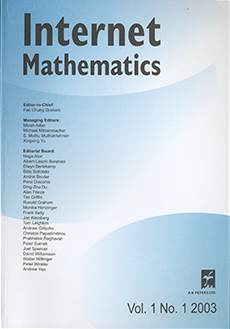Abstract
We study a random graph $G_n$ that combines certain aspects of geometric random graphs and preferential attachment graphs. The vertices of $G_n$ are $n$ sequentially generated points $x_1,x_2,\ldots,x_n$ chosen uniformly at random from the unit sphere in $\mathbb{R}^3$. After generating $x_t$, we randomly connect that point to $m$ points from those points in $x_1,x_2,\ldots,x_{t-1}$ that are within distance $r$ of $x_t$. Neighbors are chosen with probability proportional to their current degree, and a parameter $\alpha$ biases the choice towards self loops. We show that if $m$ is sufficiently large, if $r\geq \ln n / n^{1/2-\beta}$ for some constant $\beta$, and if $\alpha>2$, then with high probabilty (\whp) at time $n$ the number of vertices of degree $k$ follows a power law with exponent $\alpha+1$. Unlike the preferential attachment graph, this geometric preferential attachment graph has small separators, similar to experimental observations of Blandford, et al. We further show that if $m\geq K\ln n$, for $K$ sufficiently large, then $G_n$ is connected and has diameter $O(\ln n/r)$ \whp.
Citation
Abraham D. Flaxman. Alan M. Frieze. Juan Vera. "A Geometric Preferential Attachment Model of Networks." Internet Math. 3 (2) 187 - 206, 2006.
Information




